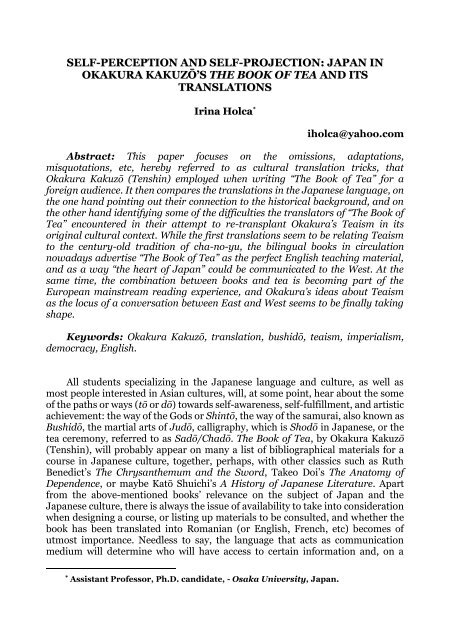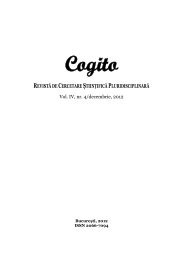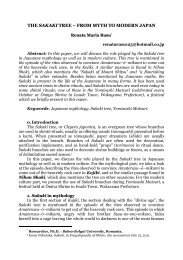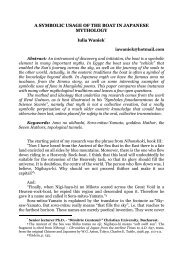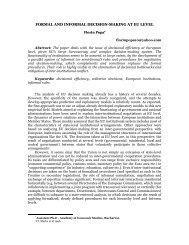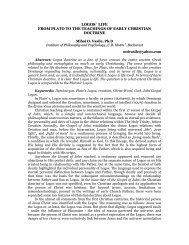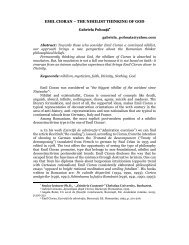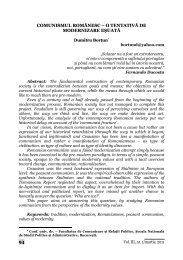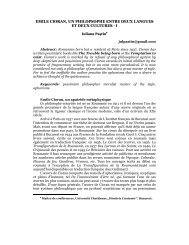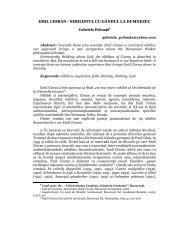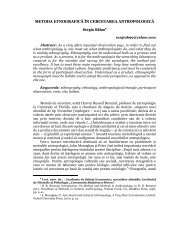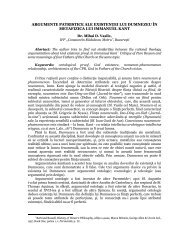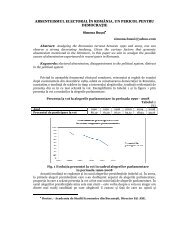japan in okakura kakuzÅ's the book of tea and its translations - cogito
japan in okakura kakuzÅ's the book of tea and its translations - cogito
japan in okakura kakuzÅ's the book of tea and its translations - cogito
You also want an ePaper? Increase the reach of your titles
YUMPU automatically turns print PDFs into web optimized ePapers that Google loves.
In his writ<strong>in</strong>g, Okakura purposefully fails to enlarge upon <strong>the</strong> connectionbetween <strong>the</strong> <strong>tea</strong> ceremony <strong>and</strong> <strong>the</strong> samurai, re-enforc<strong>in</strong>g <strong>in</strong>s<strong>tea</strong>d <strong>the</strong> fem<strong>in</strong><strong>in</strong>eimage that had been superimposed on <strong>the</strong> former with <strong>the</strong> help <strong>of</strong> some foreign<strong>and</strong> Japanese photographers/ pa<strong>in</strong>ters <strong>in</strong> search <strong>of</strong> <strong>the</strong> Asian exotic after <strong>the</strong> MeijiRestoration 13 . On <strong>the</strong> o<strong>the</strong>r h<strong>and</strong>, though, <strong>the</strong>re are a few fragments <strong>in</strong> The Book<strong>of</strong> Tea that rem<strong>in</strong>d <strong>the</strong> reader that <strong>tea</strong> was a favourite pass-time <strong>of</strong> <strong>the</strong> warriorclass, <strong>and</strong> h<strong>in</strong>t at <strong>the</strong> value attached to ideas such as self-sacrifice <strong>and</strong> honour,which are also po<strong>in</strong>t<strong>in</strong>g back to <strong>the</strong> samurai <strong>and</strong> <strong>the</strong>ir ethic, such as <strong>the</strong> follow<strong>in</strong>g:In such <strong>in</strong>stances we see <strong>the</strong> full significance <strong>of</strong> <strong>the</strong> Flower Sacrifice(...) Some flowers glory <strong>in</strong> death— certa<strong>in</strong>ly <strong>the</strong> Japanese cherryblossoms do, as <strong>the</strong>y freely surrender to <strong>the</strong> w<strong>in</strong>ds. (p.63)He who has lived with <strong>the</strong> beautiful can die beautifully (…) Oneprivilege alone was granted to <strong>the</strong> condemned— <strong>the</strong> honour <strong>of</strong> dy<strong>in</strong>g byhis own h<strong>and</strong>. (p.68)The notion <strong>of</strong> democracy, i.e., <strong>the</strong> power <strong>of</strong> <strong>the</strong> people, is also ambiguouslytreated <strong>and</strong> used <strong>in</strong> The Book <strong>of</strong> Tea. The Japanese pr<strong>in</strong>ts <strong>and</strong> artifacts–mass-produced, <strong>and</strong> consumed by <strong>the</strong> masses— brought to Europe <strong>in</strong> <strong>the</strong> secondhalf <strong>of</strong> <strong>the</strong> 19 th century had lead to <strong>the</strong> appearance <strong>and</strong> development <strong>of</strong> <strong>the</strong> arts<strong>and</strong> crafts <strong>and</strong> Art nouveau movements, <strong>and</strong> were hailed as paragons <strong>of</strong> <strong>the</strong>democratization <strong>of</strong> art. On <strong>the</strong> one h<strong>and</strong>, Okakura puts forth <strong>the</strong> idea that Teaismhas laid <strong>the</strong> foundations for an equal participation <strong>of</strong> <strong>the</strong> noble <strong>and</strong> <strong>the</strong> humble <strong>in</strong>artistic endeavours:It (<strong>the</strong> Philosophy <strong>of</strong> Tea) represents <strong>the</strong> true spirit <strong>of</strong> Easterndemocracy by mak<strong>in</strong>g all <strong>its</strong> votaries aristocrats <strong>in</strong> taste (…) Our home<strong>and</strong> hab<strong>its</strong>, costume <strong>and</strong> cuis<strong>in</strong>e, porcela<strong>in</strong>, lacquer, pa<strong>in</strong>t<strong>in</strong>g—our veryliterature— all have been subject to <strong>its</strong> <strong>in</strong>fluence (...) It has permeated <strong>the</strong>elegance <strong>of</strong> noble boudoirs, <strong>and</strong> entered <strong>the</strong> abode <strong>of</strong> <strong>the</strong> humble. Ourpeasants have learned to arrange flowers, our meanest labourer to <strong>of</strong>fersalutation to <strong>the</strong> rocks <strong>and</strong> waters. (p.1)On <strong>the</strong> o<strong>the</strong>r h<strong>and</strong>, though, he bemoans <strong>the</strong> advent <strong>of</strong> “this democratic age <strong>of</strong>ours” <strong>in</strong> which <strong>the</strong> masses have access to copies <strong>of</strong> real art <strong>in</strong> “illustratedperiodicals”, show<strong>in</strong>g that his underst<strong>and</strong><strong>in</strong>g <strong>of</strong> <strong>the</strong> democratization <strong>of</strong> art isdifferent from that underly<strong>in</strong>g <strong>the</strong> Art nouveau, <strong>in</strong>dustrial art, <strong>and</strong> arts <strong>and</strong> craftsmovements, which were all <strong>in</strong> favour <strong>of</strong> open<strong>in</strong>g up art for mass-production <strong>and</strong>consumption, thus educat<strong>in</strong>g <strong>and</strong> empower<strong>in</strong>g <strong>the</strong> masses.Perhaps we are now pass<strong>in</strong>g through an age <strong>of</strong> democratisation <strong>in</strong>art, while await<strong>in</strong>g <strong>the</strong> rise <strong>of</strong> some pr<strong>in</strong>cely master who shall establish anew dynasty. (p.41)In this democratic age <strong>of</strong> ours men clamour for what is popularlyconsidered <strong>the</strong> best, regardless <strong>of</strong> <strong>the</strong>ir feel<strong>in</strong>gs (...) To <strong>the</strong> masses,13 One <strong>of</strong> <strong>the</strong> most famous such photographers is Felice Beato, whose pictures <strong>of</strong>tenimmortalize frightful samurai <strong>in</strong> full armour, seppuku practices or decapitations, as well as delicatewomen <strong>in</strong> beautiful kimonos, busy serv<strong>in</strong>g <strong>tea</strong>, arrang<strong>in</strong>g flowers or play<strong>in</strong>g <strong>the</strong> shamisen.
contemplation <strong>of</strong> illustrated periodicals, <strong>the</strong> worthy product <strong>of</strong> <strong>the</strong>ir own<strong>in</strong>dustrialism, would give more digestible food for artistic enjoymentthan <strong>the</strong> early Italians or <strong>the</strong> Ashikaga masters, whom <strong>the</strong>y pretend toadmire. (p.51)While Okakura does make ambiguous all references to <strong>the</strong> historicalconnection between <strong>the</strong> cha-no-yu <strong>and</strong> <strong>the</strong> rul<strong>in</strong>g classes, <strong>in</strong> <strong>the</strong> end hisdemocracy is one only <strong>the</strong> “civilized” elites <strong>of</strong> Japan <strong>and</strong> <strong>the</strong> world can enjoy.One o<strong>the</strong>r contradiction <strong>in</strong> The Book <strong>of</strong> Tea is that, at <strong>the</strong> height <strong>of</strong> worldwideimperialism <strong>and</strong> dur<strong>in</strong>g a period marred by wars waged for expansion <strong>and</strong>dom<strong>in</strong>ation, Okakura blames <strong>the</strong> bloodshed <strong>of</strong> <strong>the</strong> Russo-Japanese battlefields on“European imperialism”, while completely “forgett<strong>in</strong>g” <strong>the</strong> fact that <strong>the</strong> conflictsthat had started with <strong>the</strong> S<strong>in</strong>o-Japanese War <strong>of</strong> 1894-95, cont<strong>in</strong>ued all through<strong>the</strong> next four decades <strong>and</strong> f<strong>in</strong>ally developed <strong>in</strong>to <strong>the</strong> Second S<strong>in</strong>o-Japanese Warare backed by <strong>the</strong> same logic:The beg<strong>in</strong>n<strong>in</strong>g <strong>of</strong> <strong>the</strong> twentieth century would have been spared <strong>the</strong>spectacle <strong>of</strong> sangu<strong>in</strong>ary warfare if Russia had condescended to knowJapan better. What dire consequences to humanity lie <strong>in</strong> <strong>the</strong>contemptuous ignor<strong>in</strong>g <strong>of</strong> Eastern problems! European imperialism,which does not disda<strong>in</strong> to raise <strong>the</strong> absurd cry <strong>of</strong> <strong>the</strong> Yellow Peril, fails torealize that Asia may also awaken to <strong>the</strong> cruel sense <strong>of</strong> <strong>the</strong> WhiteDisaster. (p.5)He f<strong>in</strong>ds <strong>the</strong> European territorial claims unfair, but does not cl<strong>in</strong>ch <strong>in</strong> front <strong>of</strong>Japan’s, because, as he <strong>of</strong>ten h<strong>in</strong>ts <strong>in</strong> his writ<strong>in</strong>g, Japan is <strong>the</strong> best part <strong>of</strong> Asia, <strong>the</strong>place where various Asian arts, such as <strong>the</strong> <strong>tea</strong> ceremony, have been brought toperfection, <strong>and</strong> thus <strong>the</strong> rightful leader <strong>of</strong> all Asian countries:It is <strong>in</strong> <strong>the</strong> Japanese <strong>tea</strong> ceremony that we see <strong>the</strong> culm<strong>in</strong>ation <strong>of</strong><strong>tea</strong>-ideals. Our successful resistance <strong>of</strong> <strong>the</strong> Mongol <strong>in</strong>vasion <strong>in</strong> 1281 hadenabled us to carry on <strong>the</strong> Sung movement (...) Tea with us became morethan an idealization <strong>of</strong> <strong>the</strong> form <strong>of</strong> dr<strong>in</strong>k<strong>in</strong>g; it is a religion <strong>of</strong> <strong>the</strong> art <strong>of</strong>life. (p.19)As mentioned above, Okakura’s Book <strong>of</strong> Tea had to wait for more than twentyyears for <strong>its</strong> first translation <strong>in</strong> <strong>the</strong> Japanese language. Part <strong>of</strong> this was likely dueto <strong>the</strong> author’s eccentric personality <strong>and</strong> lifestyle, which had endeared him withhis foreigner friends, but estranged him from his Japanese supporters. Moreover,<strong>the</strong> plea for peace explicit <strong>in</strong> <strong>the</strong> <strong>book</strong> was <strong>in</strong> sharp contrast with <strong>the</strong> ambitions <strong>of</strong>a Japan that had just emerged victorious from <strong>the</strong> conflict with one <strong>of</strong> <strong>the</strong>European powers, <strong>and</strong> was attempt<strong>in</strong>g to exp<strong>and</strong> <strong>its</strong> borders to <strong>in</strong>clude parts <strong>of</strong>Asia such as Manchuria <strong>and</strong> Korea.On <strong>the</strong> o<strong>the</strong>r h<strong>and</strong>, Inazō Nitobe’s Bushidō: <strong>the</strong> Soul <strong>of</strong> Japan, appeared to bemuch more <strong>in</strong> tune with (or much easier to attune to) Japan’s foreign policies <strong>and</strong>self-projected outer image. Shortly after be<strong>in</strong>g published <strong>in</strong> 1900 <strong>in</strong> <strong>the</strong> U.S., itappeared <strong>in</strong> English from a Japanese publish<strong>in</strong>g house too, <strong>and</strong> new editions kept
com<strong>in</strong>g almost every year 14 . The first translation saw <strong>the</strong> light <strong>of</strong> day <strong>in</strong> 1908 15 ; by<strong>the</strong> late 1930s, it had already been revised once <strong>in</strong> 1918, <strong>and</strong> jo<strong>in</strong>ed by two new<strong>translations</strong> <strong>in</strong> 1935 16 <strong>and</strong> 1938 17 . Just like The Book <strong>of</strong> Tea, it cannot be aco<strong>in</strong>cidence that publications <strong>and</strong> <strong>translations</strong> are grouped around <strong>the</strong> late 1930s,<strong>in</strong> preparation, as it were, for <strong>the</strong> celebration <strong>of</strong> 2600 years s<strong>in</strong>ce <strong>the</strong>enthronement <strong>of</strong> J<strong>in</strong>mu; as it is no wonder that, unlike The Book <strong>of</strong> Tea, neweditions <strong>of</strong> Bushido stopped appear<strong>in</strong>g after <strong>the</strong> Second World War, to re-surfaceonly <strong>in</strong> <strong>the</strong> 1970s.All <strong>of</strong> <strong>the</strong> early translators <strong>of</strong> The Book <strong>of</strong> Tea <strong>in</strong>voke Okakura’s very<strong>in</strong>sightful words about translation:Translation is always a treason, <strong>and</strong> as a M<strong>in</strong>g author observes, canat <strong>its</strong> best be only <strong>the</strong> reverse side <strong>of</strong> a brocade,— all <strong>the</strong> threads are<strong>the</strong>re, but not <strong>the</strong> subtlety <strong>of</strong> colour or design. (p.22)This applies all <strong>the</strong> more to The Book <strong>of</strong> Tea, s<strong>in</strong>ce it is, <strong>in</strong> a way, a patchwork<strong>of</strong> Japanese <strong>and</strong> Asian culture, translated <strong>in</strong>to English, <strong>and</strong> <strong>the</strong>n re-translated <strong>in</strong>toJapanese, on whose reverse millions <strong>of</strong> threads are tangled <strong>and</strong> <strong>in</strong>tertw<strong>in</strong>ed.First <strong>of</strong> all, a challenge Okakura himself had to face was translat<strong>in</strong>g <strong>in</strong>toEnglish classical Japanese or Ch<strong>in</strong>ese texts, or concepts. Render<strong>in</strong>g different types<strong>of</strong> discourse, from classical Japanese to kanbun, from poetry to dailyconversations, <strong>in</strong>to <strong>the</strong> same English <strong>of</strong> <strong>the</strong> beg<strong>in</strong>n<strong>in</strong>g <strong>of</strong> <strong>the</strong> 20 th century does takeaway some <strong>of</strong> “<strong>the</strong> subtlety <strong>of</strong> colour <strong>and</strong> design”, <strong>in</strong> exchange for accessibility, butafter all this was Okakura’s purpose: to make parts <strong>of</strong> <strong>the</strong> Japanese cultureaccessible to foreigners, <strong>and</strong> to this end he used all methods at h<strong>and</strong>, even co<strong>in</strong><strong>in</strong>gnew words such as “Teaism” or “White Peril”.The tricks Okakura used to make Japanese/ Asian culture comprehensible to<strong>the</strong> West later became issues on which his translators <strong>in</strong>to Japanese must havepondered <strong>and</strong> disagreed. While not directly connected to political agendas, <strong>the</strong>way each <strong>of</strong> <strong>the</strong>m chose to tackle <strong>the</strong>se difficulties is an <strong>in</strong>dication <strong>of</strong> <strong>the</strong> changes<strong>in</strong> <strong>the</strong> way “translation” was perceived, <strong>and</strong> <strong>of</strong> <strong>the</strong> position <strong>the</strong> reader came tooccupy through <strong>the</strong> ages.Let us now take a look at some <strong>of</strong> what I would like to call “culturaltranslation tricks” which carry <strong>and</strong> alter mean<strong>in</strong>g while travel<strong>in</strong>g back <strong>and</strong> forthbetween Japanese <strong>and</strong> English.First <strong>of</strong> all, <strong>the</strong>re is “Teaism”, <strong>the</strong> word co<strong>in</strong>ed by Okakura to refer to <strong>the</strong> ma<strong>in</strong>topic <strong>of</strong> his <strong>book</strong>. As previous studies have <strong>in</strong>dicated, <strong>the</strong> term was meant to jo<strong>in</strong><strong>the</strong> plethora <strong>of</strong> “isms” used to describe western art, literature <strong>and</strong> culture 18 ; what14 First published <strong>in</strong> 1901 from <strong>the</strong> Shokabō Publish<strong>in</strong>g House, <strong>the</strong>n <strong>in</strong> 1904 from The StudentCompany, <strong>and</strong> afterwards <strong>in</strong> numerous editions from Teibi Publish<strong>in</strong>g House (1905, 1907, 1908,1911, 1912, etc).15 Translated by Sakurai Ōson, for Teibi Publish<strong>in</strong>g House.16 Translated by Harusato Kondō& Ishii Kikujirō for Keibundō.17 Translated by Tadao Yanagihara for Iwanami Bunko.18 Naoko Fuwa Thornton, Translation as a Counter-Colonial Tool, <strong>in</strong> Japan Women’sUniversity Studies <strong>in</strong> English <strong>and</strong> American Literature, no.40, 2005.
Okakura talks about <strong>in</strong> his essays is a universal philosophy <strong>of</strong> life <strong>and</strong> art that canbe expla<strong>in</strong>ed <strong>and</strong> understood <strong>in</strong> a language different from that <strong>of</strong> <strong>the</strong> culturewhich gave birth to it; a school <strong>of</strong> thought perfectly fit for <strong>the</strong> modern world,outside Japan. As a matter <strong>of</strong> fact, very few Japanese words are used <strong>in</strong> expla<strong>in</strong><strong>in</strong>gTeaism, <strong>and</strong> <strong>the</strong> terms cha-no-yu or sado never once appear. On <strong>the</strong> o<strong>the</strong>r h<strong>and</strong>,Inazō Nitobe’s <strong>book</strong> has a Japanese word <strong>in</strong> <strong>its</strong> title, bushidō, which it served topopularize fur<strong>the</strong>r, along with samurai, ano<strong>the</strong>r term frequently used <strong>in</strong> <strong>the</strong> text.In The Book <strong>of</strong> Tea, Teaism is contrasted with bushidō, <strong>the</strong> way <strong>of</strong> <strong>the</strong> samuraiwith <strong>the</strong> philosophy <strong>of</strong> <strong>tea</strong>, not only at <strong>the</strong> “signified” level, i.e., <strong>the</strong> contents, butalso at a “signifier” level, i.e., <strong>the</strong> word used to refer to those contents. In do<strong>in</strong>g so,Okakura is attempt<strong>in</strong>g to <strong>in</strong>troduce <strong>tea</strong> as a potentially modern <strong>and</strong> universal artform, while bushidō is left anchored <strong>in</strong> Japan’s feudal past. Unfortunately, none <strong>of</strong><strong>the</strong> <strong>translations</strong> that I have chosen to analyze <strong>and</strong> discuss <strong>in</strong> my presentation havesucceeded <strong>in</strong> preserv<strong>in</strong>g this nuance; <strong>the</strong>y all use sadō, <strong>and</strong> occasionallycha-no-yu to render Okakura’s Teaism <strong>in</strong> Japanese, thus robb<strong>in</strong>g it <strong>of</strong> <strong>its</strong> modern<strong>and</strong> westernized ambitions, <strong>and</strong> tak<strong>in</strong>g one important dimension out <strong>of</strong> <strong>the</strong>Bushido-Teaism ant<strong>in</strong>omy.Ano<strong>the</strong>r noteworthy feature <strong>of</strong> <strong>the</strong> “cultural translation” pervad<strong>in</strong>g The Book<strong>of</strong> Tea is that Okakura not only quotes, but sometimes, under <strong>the</strong> guise <strong>of</strong>translation, even twists, approximates <strong>and</strong> simplifies, without quotation marks,numerous episodes, anecdotes <strong>and</strong> poems from Ch<strong>in</strong>ese or classical Japanese. On<strong>the</strong> o<strong>the</strong>r h<strong>and</strong>, his translators too go beyond mere translation, <strong>and</strong> are add<strong>in</strong>g to<strong>the</strong> “texture” threads that Okakura had deemed unnecessary for his Americanaudience. Thus, Confucius’s words, or <strong>the</strong> quotations from Luwuh’s Chak<strong>in</strong>g, or<strong>the</strong> poem Sen-no-Rikyū wrote just before his death, <strong>in</strong>serted <strong>in</strong> pla<strong>in</strong> English <strong>in</strong>Okakura’s text, appear <strong>in</strong> both Muraoka Hiroshi’s 19 <strong>and</strong> Watanabe Masatomo’s 20<strong>translations</strong> <strong>in</strong> <strong>the</strong> orig<strong>in</strong>al kanbun style, mean<strong>in</strong>g that <strong>the</strong> translators went backto <strong>the</strong> sources <strong>of</strong> Okakura’s text <strong>and</strong> quoted it <strong>in</strong> <strong>the</strong> orig<strong>in</strong>al, regardless <strong>of</strong> <strong>the</strong> factthat <strong>the</strong> said orig<strong>in</strong>al had been altered to suit a different purpose <strong>in</strong> <strong>the</strong> Englishversion. Thus, <strong>in</strong> The Book <strong>of</strong> Tea, <strong>the</strong> conversation between <strong>the</strong> TaoistChuang-tse <strong>and</strong> his disciple is <strong>in</strong> simple, easy to underst<strong>and</strong> English; <strong>in</strong> Muraoka’s1929 translation, <strong>the</strong> episode appears <strong>in</strong> classical Ch<strong>in</strong>ese, without anyexplanations, while <strong>the</strong> 1938 revised translation 21 <strong>in</strong>cludes an explanatoryfootnote from <strong>the</strong> translator. Watanabe’s 1936 translation <strong>in</strong>cluded <strong>in</strong> Okakura’sComplete Works also uses only <strong>the</strong> kanbun version. In <strong>the</strong> same translation byWatanabe, ano<strong>the</strong>r conversation, between <strong>the</strong> Zen patriarch Yeno <strong>and</strong> two monksis rendered <strong>in</strong> modern Japanese, but with <strong>the</strong> kanbun text <strong>in</strong> brackets; a few morevariations are present <strong>in</strong> <strong>the</strong> above-mentioned Japanese versions.In a nutshell, Okakura’s wise men <strong>of</strong> <strong>the</strong> old days are made to converse <strong>in</strong> avernacular understood by modern men all over <strong>the</strong> world— <strong>and</strong> which wassubsequently easily <strong>and</strong> promptly translated, no complicated cross-referencestr<strong>in</strong>gs attached, <strong>in</strong>to o<strong>the</strong>r idioms <strong>of</strong> <strong>the</strong> western world. Never<strong>the</strong>less, for <strong>the</strong>19 Iwanami Bunko (publish<strong>in</strong>g house), 1929.20 Seibunkaku (publish<strong>in</strong>g house), 1936.21 Iwanami Bunko (publish<strong>in</strong>g house).
Japanese translators, Okakura’s work was far from a neutral translat<strong>in</strong>gexperience, as <strong>the</strong>y could not ignore <strong>the</strong> str<strong>in</strong>gs that tied The Book <strong>of</strong> Tea toJapanese culture. Just as when <strong>the</strong>y had translated Teaism as sadō, by<strong>in</strong>troduc<strong>in</strong>g kanbun <strong>in</strong>to <strong>the</strong>ir versions <strong>of</strong> Okakura’s work, <strong>the</strong>y stifled some <strong>of</strong> <strong>the</strong>universality <strong>and</strong> modernity <strong>the</strong> <strong>book</strong> was meant to convey. As compared to <strong>the</strong>first edition <strong>in</strong> 1929, <strong>the</strong> new translation <strong>of</strong> 1936 <strong>and</strong> <strong>the</strong> revised one <strong>of</strong> 1938 doconta<strong>in</strong> more notes <strong>and</strong> explanations, thus be<strong>in</strong>g open to a wider readership. On<strong>the</strong> o<strong>the</strong>r h<strong>and</strong>, <strong>in</strong> Asano Akira’s 1956 translation, for <strong>the</strong> first time, Okakura’sEnglish text is rendered exclusively <strong>in</strong>to modern Japanese, while <strong>the</strong> quoted oro<strong>the</strong>rwise referred to sources are mentioned only <strong>in</strong> <strong>the</strong> endnotes.The changes <strong>in</strong> <strong>the</strong> way “translat<strong>in</strong>g” was approached <strong>in</strong> <strong>the</strong> course <strong>of</strong> timemark <strong>the</strong> changes <strong>in</strong> <strong>the</strong> target readership <strong>of</strong> The Book <strong>of</strong> Tea. While <strong>the</strong> 1929readers were expected to underst<strong>and</strong> kanbun, <strong>the</strong> 1936-38 readers already neededhelp with it, while <strong>in</strong> 1956 modern Japanese had become <strong>the</strong> only choice for <strong>the</strong>translation. At <strong>the</strong> same time, <strong>the</strong> features that <strong>the</strong>se three <strong>translations</strong> sharepo<strong>in</strong>t to a common attempt to br<strong>in</strong>g out <strong>the</strong> Japanese-ness <strong>of</strong> <strong>the</strong> <strong>tea</strong> ceremony,<strong>and</strong> to connect it to an Asian/ Japanese tradition that Okakura had tried to blurout, by co<strong>in</strong><strong>in</strong>g an “ism” term to refer to it, <strong>and</strong> by hid<strong>in</strong>g on <strong>the</strong> back <strong>of</strong> <strong>the</strong>brocade most <strong>of</strong> <strong>the</strong> threads connect<strong>in</strong>g it to <strong>the</strong> above-mentioned tradition.Okakura’s Teaism is a cosmopolitan art, to be enjoyed <strong>in</strong> <strong>the</strong> salons <strong>of</strong> <strong>the</strong>well-to-do collectors all over <strong>the</strong> world, while <strong>the</strong> translated Book <strong>of</strong> Tea is moreanchored <strong>in</strong>to an old Japan, which makes it <strong>the</strong> perfect <strong>book</strong> to publish <strong>and</strong> readaround <strong>the</strong> celebrations <strong>of</strong> 2600 years from <strong>the</strong> enthronement <strong>of</strong> Japan’s firstemperor, J<strong>in</strong>mu (1940), or <strong>in</strong> <strong>the</strong> years after <strong>the</strong> second World War.Just a few words, at <strong>the</strong> end, about <strong>the</strong> Romanian <strong>translations</strong>. The first oneappeared <strong>in</strong> 1925, <strong>and</strong> belongs to Emanoil Bucuta 22 . An <strong>in</strong>terest<strong>in</strong>g th<strong>in</strong>g to note isthat <strong>the</strong> translator mentions <strong>in</strong> <strong>the</strong> Foreword that he had <strong>in</strong>itially used The Book<strong>of</strong> Tea <strong>in</strong> order to brush up his English skills. My own translation appeared <strong>in</strong>2008 from <strong>the</strong> Nemira Publish<strong>in</strong>g House. Its commercial success was backed by<strong>the</strong> association between <strong>book</strong>s <strong>and</strong> <strong>tea</strong> that is lately be<strong>in</strong>g made <strong>in</strong> Romania,where it has become fashionable for <strong>book</strong>stores to have an attached <strong>tea</strong>housewhere <strong>the</strong> customers can consecrate <strong>the</strong>mselves to <strong>the</strong> “queen <strong>of</strong> <strong>the</strong> Camellias,<strong>and</strong> revel <strong>in</strong> <strong>the</strong> warm stream <strong>of</strong> sympathy that flows from her altar” 23 , while go<strong>in</strong>gthrough <strong>the</strong> pages <strong>of</strong> some <strong>book</strong> or o<strong>the</strong>r. This tendency is doubled by an ongo<strong>in</strong>g<strong>in</strong>terest for <strong>the</strong> <strong>tea</strong> ceremony: cha-no-yu demonstrations are held regularly <strong>and</strong>never fail to attract an audience <strong>of</strong> Japan enthusiasts. While we can say that <strong>the</strong>Japanese <strong>tea</strong>, along with hundreds <strong>of</strong> o<strong>the</strong>r <strong>tea</strong>s from all over <strong>the</strong> world, sipped by<strong>the</strong> young cosmopolitan <strong>in</strong> chic <strong>tea</strong>houses while go<strong>in</strong>g through <strong>the</strong> pages <strong>of</strong> a <strong>book</strong>or chatt<strong>in</strong>g with friends, is closer to Okakura’s idea <strong>of</strong> East <strong>and</strong> West reconcil<strong>in</strong>g <strong>in</strong>a cup <strong>of</strong> amber liquid, I th<strong>in</strong>k it is still <strong>the</strong> underly<strong>in</strong>g exotic that attracts. Thesuccess <strong>of</strong> The Book <strong>of</strong> Tea abroad, now <strong>and</strong> <strong>the</strong>n, is clearly due to <strong>the</strong> fact that itpresents a simplified image, an essence <strong>of</strong> Japanese-ness as Okakura saw it fit forforeign eyes—<strong>the</strong> same type <strong>of</strong> vision that he had adopted when discover<strong>in</strong>g his22 From Fundatia Culturala Pr<strong>in</strong>cipele Carol, Bucharest.23 The Book <strong>of</strong> Tea, above-mentioned edition, p.2.
own country <strong>in</strong> <strong>the</strong> company <strong>of</strong> foreign guests, perceiv<strong>in</strong>g it through <strong>the</strong>ir eyes, or,later, when he attempted to project himself as an embodiment <strong>of</strong> Japan to hisAmerican audience.For <strong>the</strong> Japanese public, on <strong>the</strong> o<strong>the</strong>r h<strong>and</strong>, when The Book <strong>of</strong> Tea was firsttranslated, it must have appeared to lack substance, <strong>and</strong> supplementary<strong>in</strong>formation was necessary to make <strong>the</strong> “brocade” complete; a wealth <strong>of</strong> sourcesabout <strong>the</strong> <strong>tea</strong> ceremony was available, <strong>and</strong> most <strong>of</strong> <strong>the</strong>m connected it tocentury-old traditions, which many readers were aware <strong>of</strong>. Thus, it was difficultfor Okakura’s newly co<strong>in</strong>ed “ism” to f<strong>in</strong>d <strong>its</strong> place as a moderniz<strong>in</strong>g concept, <strong>in</strong>sideJapanese culture. Never<strong>the</strong>less, recently The Book <strong>of</strong> Tea has been revived <strong>in</strong> abil<strong>in</strong>gual collection from Kōdansha Publish<strong>in</strong>g House 24 , conta<strong>in</strong><strong>in</strong>g <strong>book</strong>s which<strong>the</strong> Japanese are encouraged to read <strong>in</strong> order to improve <strong>the</strong>ir English, so as to beable to discuss <strong>the</strong>ir country’s culture, politics, economy, etc, with foreigners. AJapanese native’s accomplishments <strong>in</strong> <strong>the</strong> English language are given as anexample to <strong>the</strong> thous<strong>and</strong>s <strong>of</strong> Japanese who are struggl<strong>in</strong>g today with <strong>the</strong> complex<strong>of</strong> not be<strong>in</strong>g able to master <strong>the</strong> foreign idiom— just as, on <strong>the</strong> o<strong>the</strong>r side <strong>of</strong> <strong>the</strong>globe, it had served as a self-<strong>tea</strong>ch<strong>in</strong>g material to <strong>the</strong> Romanian translatorEmanoil Bucuta.And thus, over one hundred years after publication, <strong>in</strong> <strong>the</strong> newly discoveredpassion for <strong>tea</strong> <strong>and</strong> <strong>book</strong>s <strong>of</strong> <strong>the</strong> young cosmopolitan, <strong>and</strong> <strong>in</strong> <strong>the</strong> Japaneseattempts at English self-expression, Okakura’s aims <strong>and</strong> aspirations live on, <strong>and</strong>Teaism is re-conquer<strong>in</strong>g <strong>the</strong> world <strong>and</strong> Japan.REFERENCES1. Okakura Kakuzō, The Book <strong>of</strong> Tea, N.Y., Fox Duffield, 1906, <strong>and</strong> <strong>the</strong>Dreamsmyth edition <strong>of</strong> William Adams (U.S., 2001), also available as an eBook athttp://www.tetons<strong>and</strong>s.us/.2. Okakura Kakuzō, Cha no hon, Tokyo, Iwanami Bunko, 1928 (1939); transl.Muraoka Hiroshi;3. Okakura Kakuzō, Okakura Tensh<strong>in</strong> Zenshu, Tokyo, Seibunkaku, 1936;transl. Watanabe Masatomo;4. Okakura Kakuzō, Cha no hon, Tokyo, Kadokawa Bunko, 1956; transl.Asano Akira;5. Inazō Nitobe, Bushidō: <strong>the</strong> Soul <strong>of</strong> Japan. An Exposition <strong>of</strong> JapaneseThought, Philadelphia, Leeds& Biddle, 1900;6. Cristopher Benfey, The Great Wave: Gilded Age Misf<strong>its</strong>, JapaneseEccentrics <strong>and</strong> <strong>the</strong> Open<strong>in</strong>g <strong>of</strong> Old Japan, N.Y., R<strong>and</strong>om House, 2003;7. Ives Colta, The Great Wave: The Influence <strong>of</strong> Japanese Woodcuts onFrench Pr<strong>in</strong>ts, N.Y., Metropolitan Museum <strong>of</strong> Arts, 1974;8. Toshio Yokoyama, Japan <strong>in</strong> <strong>the</strong> Victorian M<strong>in</strong>d: A Study <strong>of</strong> StereotypedImages <strong>of</strong> a Nation, MacMillan, 1987;24 Published first <strong>in</strong> 1998. 2010 edition consulted. O<strong>the</strong>r titles <strong>in</strong>clude, for example, Nitobe’sBushidō, or Eigo de Nihon Ryōri [Japanese Cuis<strong>in</strong>e <strong>in</strong> English], Eigo de Hanasu Nihon Bunka[Japanese Culture Expla<strong>in</strong>ed <strong>in</strong> English], Eigo de yomu Nihon-shi [Read<strong>in</strong>g Japanese History <strong>in</strong>Japanese], Eigo de Hanasu Nihon no keizai [Japanese Economy <strong>in</strong> English], etc.
9. Sydney Giffard, Japan Among <strong>the</strong> Powers 1890-1990, New Haven&London, Yale University Press, 1994;10. W.G. Beasley, Japanese Imperialism, 1894-1945, NY, Oxford UniversityPress, 1987;11. Naoko Fuwa Thornton, Translation as a Counter-Colonial Tool, <strong>in</strong> JapanWomen’s University Studies <strong>in</strong> English <strong>and</strong> American Literature vol.40, 2005;12. Christ<strong>in</strong>e M.E. Guth, Charles Longfellow <strong>and</strong> Okakura Kakuzo: CulturalCross-Dress<strong>in</strong>g <strong>in</strong> <strong>the</strong> Colonial Context, <strong>in</strong> Positions: East Asia Cultures Critiquevol.8, 2000;13. Asano Akira, Okakura Tensh<strong>in</strong> Ronkō [On Okakura Tensh<strong>in</strong>], Tokyo,Shishosha, 1939;14. K<strong>in</strong>oshita Junji, Waga Okakura Tensh<strong>in</strong> [Personal Views about OkakuraTensh<strong>in</strong>], <strong>in</strong> The Complete Works <strong>of</strong> Okakura Tensh<strong>in</strong>, vol.1, Tokyo, Heibonsha,1979;15. Shibata Kaoru, Okakura Tensh<strong>in</strong> no Kokusai Kankaku— Eibun Chosakuwo Tsuranuku R<strong>in</strong>en [Okakura Tensh<strong>in</strong>’s Internationalism: <strong>the</strong> Ideology at <strong>the</strong>Basis <strong>of</strong> his English Works], <strong>in</strong> Izura Ronsō, vol.9, 2008;16. Ikeuchi Satoshi, Okakura Tensh<strong>in</strong> “Cha no Hon” to Tōyō no Katachi[Okakura Tensh<strong>in</strong>’s The Book <strong>of</strong> Tea <strong>and</strong> <strong>the</strong> Orient], <strong>in</strong> Bungei Shunshū, vol.82,2004;17. Ōkubo Takaki, Okakura Tensh<strong>in</strong> to Datsu-k<strong>in</strong>daishikō no Kanōsei[Okakura Tensh<strong>in</strong> <strong>and</strong> <strong>the</strong> Possibility <strong>of</strong> Anti-modernity], <strong>in</strong> Izura Ronsō, vol.15,2002;18. Kawazoe Shōji, Okakura Tensh<strong>in</strong> ni okeru Tōyō to Seiyō— Cha no HonDaiisshō wo Chush<strong>in</strong> ni [Okakura Tensh<strong>in</strong>’s Orient <strong>and</strong> Occident: Focus<strong>in</strong>g on<strong>the</strong> First Chapter <strong>of</strong> The Book <strong>of</strong> Tea], <strong>in</strong> Kokugogaku Ronshū, 1993;19. Murai Takayuki, Cha no Hon Saidoku— Bunka Kōryū no Shiten Kara[The Book <strong>of</strong> Tea Revisited: From <strong>the</strong> Po<strong>in</strong>t <strong>of</strong> View <strong>of</strong> Cultural Exchange], <strong>in</strong>K<strong>in</strong>dai, vol.73, 1992.


